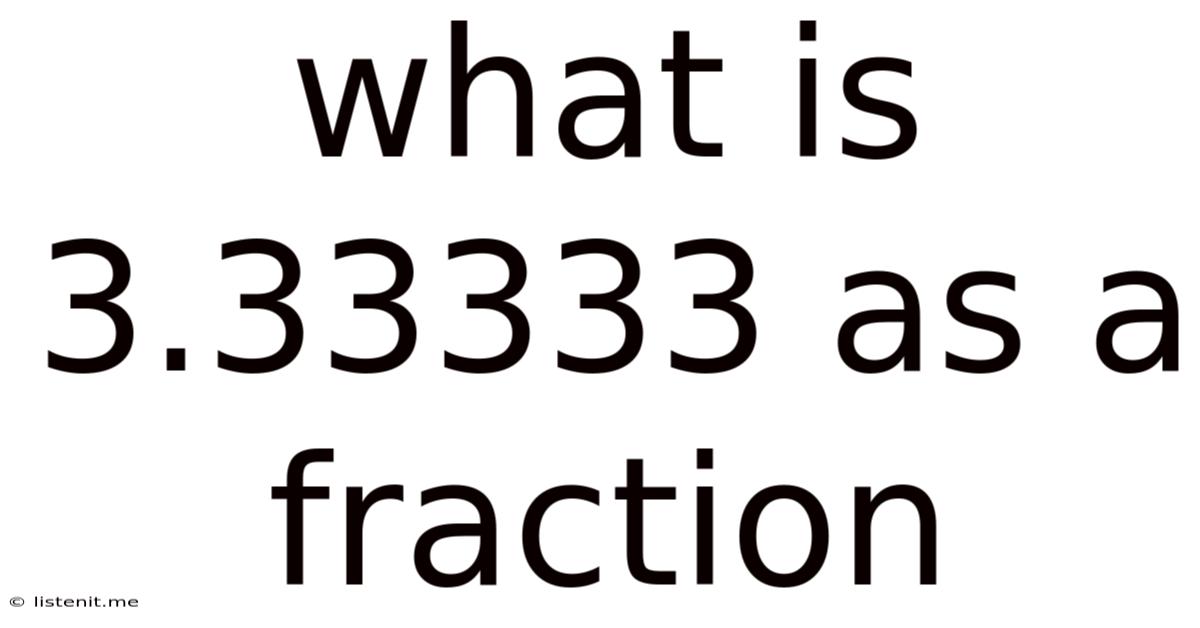What Is 3.33333 As A Fraction
listenit
May 12, 2025 · 4 min read

Table of Contents
What is 3.33333... as a fraction? Unveiling the Mystery of Repeating Decimals
The seemingly simple question, "What is 3.33333... as a fraction?" hides a fascinating journey into the world of repeating decimals and their fractional equivalents. While the immediate answer might seem obvious, understanding the why behind the conversion is key to grasping fundamental mathematical concepts. This article will delve deep into this question, exploring the process of converting repeating decimals to fractions, providing multiple methods, and highlighting the underlying mathematical principles. We'll also explore variations and related concepts to give you a comprehensive understanding.
Understanding Repeating Decimals
Before we tackle the conversion, let's clarify what a repeating decimal is. A repeating decimal, also known as a recurring decimal, is a decimal number that has a digit or a group of digits that repeat infinitely. In our case, 3.33333... is a repeating decimal because the digit "3" repeats endlessly. We represent this using a bar over the repeating digit(s): 3.$\overline{3}$.
The presence of this infinitely repeating pattern distinguishes it from terminating decimals (like 0.25 or 0.75) which have a finite number of digits after the decimal point. This seemingly small difference leads to a different approach when converting to a fraction.
Method 1: The Algebraic Approach
This method uses algebraic manipulation to solve for the fractional representation. It's a powerful and widely applicable technique:
-
Assign a variable: Let x = 3.$\overline{3}$.
-
Multiply to shift the decimal: Multiply both sides of the equation by 10 to shift the repeating part: 10x = 33.$\overline{3}$.
-
Subtract the original equation: Subtract the original equation (x = 3.$\overline{3}$) from the modified equation (10x = 33.$\overline{3}$): 10x - x = 33.$\overline{3}$ - 3.$\overline{3}$
-
Simplify: This simplifies to 9x = 30.
-
Solve for x: Divide both sides by 9: x = 30/9
-
Simplify the fraction: Reduce the fraction to its simplest form by dividing both the numerator and denominator by their greatest common divisor (GCD), which is 3: x = 10/3
Therefore, 3.$\overline{3}$ is equal to 10/3.
Method 2: Using the Formula for Infinite Geometric Series
This method utilizes the concept of an infinite geometric series. A geometric series is a sequence where each term is found by multiplying the previous term by a constant value (the common ratio). An infinite geometric series has an infinite number of terms.
The formula for the sum of an infinite geometric series is:
S = a / (1 - r)
Where:
- S is the sum of the series.
- a is the first term.
- r is the common ratio (must be between -1 and 1 for the series to converge).
In our case:
- The decimal 3.$\overline{3}$ can be rewritten as 3 + 0.3 + 0.03 + 0.003 + ...
- This is an infinite geometric series with a = 3 and r = 1/10 (each term is multiplied by 1/10 to get the next term).
Applying the formula:
S = 3 / (1 - 1/10) = 3 / (9/10) = 3 * (10/9) = 30/9 = 10/3
Again, we arrive at the fraction 10/3.
Method 3: Understanding the Place Value System
This method provides a more intuitive understanding of the conversion. 3.33333... can be expressed as:
3 + 3/10 + 3/100 + 3/1000 + ...
This is an infinite series. While we can't directly sum an infinite number of terms, we can use the concept of limits to find the sum. The sum approaches 10/3 as we add more and more terms.
This method emphasizes the underlying place value system in decimals and the relationship between the decimal representation and its fractional form.
Variations and Extensions
The methods described above are applicable to other repeating decimals. Let's consider a slightly more complex example: 0.$\overline{142857}$
This would require modifying the algebraic approach by multiplying by 1,000,000 (since there are six repeating digits). The process remains similar, although the calculations become more involved. Similarly, the geometric series approach would involve adapting the values of 'a' and 'r' to reflect the repeating sequence.
Practical Applications
Understanding the conversion of repeating decimals to fractions is not just a theoretical exercise. It's crucial in various fields:
- Engineering and Physics: Precise calculations often require fractional representations for accurate results.
- Computer Science: Representing numbers in different bases and handling numerical precision in algorithms necessitate a solid understanding of these concepts.
- Finance and Accounting: Calculations involving percentages and interest rates frequently use fractions.
Conclusion
Converting the repeating decimal 3.$\overline{3}$ to a fraction, which equals 10/3, is achievable through various methods. The algebraic approach, utilizing the formula for infinite geometric series, and understanding the place value system all lead to the same result. Mastering these techniques equips you with valuable skills for handling repeating decimals and solving related problems in diverse fields. Remember, the key is to understand the underlying mathematical principles and choose the method that best suits your needs and understanding. The journey from a seemingly simple decimal to its equivalent fraction unveils a deeper appreciation for the elegance and power of mathematics.
Latest Posts
Latest Posts
-
How Many Liters Are In One Mole
May 12, 2025
-
What Is The Sum Of Unit Fractions
May 12, 2025
-
What Is The Sequence Of The Complementary Strand Of Dna
May 12, 2025
-
52 Is 130 Of What Number
May 12, 2025
-
Is 30 Odd Or Even Number
May 12, 2025
Related Post
Thank you for visiting our website which covers about What Is 3.33333 As A Fraction . We hope the information provided has been useful to you. Feel free to contact us if you have any questions or need further assistance. See you next time and don't miss to bookmark.